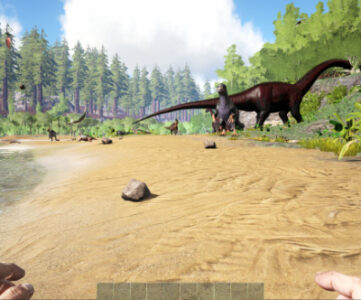[ad_1]
Our Verdict
Alan Wake 2 is a marvel, serving up intense gameplay, a twisty, dark story, and more secrets and surprises than you could possibly imagine. Remedy has outdone itself here, delivering a truly remarkable experience.
I have to admit that I had my problems with the original Alan Wake. The storytelling and atmosphere were strong, but I took issue with its linearity combined with its repetitive action, which made me cautious when Remedy announced a sequel. In our Alan Wake 2 review, I can’t exactly say that the bones of the original aren’t present, but what you’re getting in this ambitious sequel is an expanded, improved, wildly reimagined experience and ultimately one of the finest games of the year.
Alan Wake 2 picks up 13 years after the original, which left poor Alan trapped in The Dark Place. The story pivots, however, starting with an FBI agent named Saga Anderson, as she and her partner Alex Casey, who mysteriously shares a name with one of Alan’s fictional characters, investigate a rash of cult murders that have shaken the otherwise idyllic town of Bright Falls. What follows is a twisty – and twisted – narrative that takes the original’s premise to new heights.
Structurally, Alan Wake 2 is split into two. You begin the game as Saga as she explores Bright Falls and the surrounding areas before switching to Alan. You eventually gain the ability to jump back and forth between the pair, as they have their own separate stories that you’ll need to see through. You’ll mostly play as Saga in reality, while Alan’s time is spent in The Dark Place. Regardless, areas are large and persistent, and you can revisit them to search for collectibles or puzzles you may have missed during your initial trip.
As Saga, you can explore multiple self-contained areas across Bright Falls, collecting ripped-up manuscript pages as you go. After collecting enough of these, you can spend them on upgrading your arsenal, which includes a shotgun, crossbow, and rifle. There are also nursery rhyme puzzles to find that reward you with charms that grant various buffs when equipped. These maps are more rural by nature, which makes them reminiscent of the first game’s environments.
Alan’s sections, meanwhile, focus on a single interconnected area: The Dark Place’s nightmare take on New York City, which is spread across grim streets and haunted interiors. You’ll spot yellow arrows with your flashlight as you go that lead to Words of Power, which are permanent upgrades that improve your survivability and combat capabilities. Regardless of which character you’re playing as, Alan Wake 2’s level design is uniformly excellent, featuring countless unique, memorable locations that beg to be carefully explored.
Alan Wake 2’s combat is outwardly much like the first game’s, though it leans far more heavily into the realm of survival horror. Even weaker enemies can be quite dangerous, as they do a fair amount of damage on normal difficulty and teleport around at speed. Unlike the first game, there’s a decent level of enemy variety here, and encounters are tense and unnerving. The ‘Taken,’ as they’re known, look quite different in reality than they do in The Dark Place. The former bleed grotesquely, with your bullets tearing flesh from bone, while the latter’s variants have a dreamlike quality to them. In a particularly effective touch, Taken in The Dark Place are shadowy figures that can blend into the environment, keeping you on your toes at almost all times.
For the most part, you’ll still have to stun Taken with a flashlight charge to make them vulnerable, but some have glowing red cores you can shoot to deal extra damage. There’s a good variety of Alan Wake 2 weapons here, plus Saga and Alan each have their own arsenal. For instance, Saga has a pistol, while Alan has a revolver. Most importantly, these weapons feel powerful to shoot, with a good amount of kick and some strong gore effects really selling the impact. Both characters also have a dodge ability that grants invincibility frames, which comes in handy when you’re in a pinch. On all counts, Alan Wake 2 simply feels great to play, but a major difference here versus its predecessor is that combat isn’t really the main focus. Instead, it shares the stage with adventure game mechanics.
Saga has to find objects, interrogate people, and then go into her Mind Place to put clues up on a board and deduce a subject’s motives, all to figure out her next step. Deducing where clues go on the board is far more intriguing than I’d anticipated, too. Since Alan’s a writer, he instead scours locations for echoes to get inspiration, which he then uses to alter the details of a certain area. For instance, he’ll open up different paths forward by setting up a hotel lobby as the scene of a haunting or a violent murder.
Between the different maps, collectibles, and gameplay styles that exist across Saga and Alan, great work was done to make both characters feel unique from one another. There’s just such a marked difference in presentation and gameplay styles between the two, whether we’re listening to Saga’s monologue as she ponders in her Mind Place or watching live-action footage as Alan.
There was a fair amount of this juxtaposition in Control and the original Alan Wake, but the sequel takes it further, sprinkling live-action clips throughout to great effect. This footage is also nicely shot and directed. I don’t want to spoil anything, but several of these lead to some of the most bizarrely unique sequences I’ve ever seen in a videogame. The visuals are pristine, with atmospheric, lush environments colored red by the setting sun or doused in neon by city lights. All told, Alan Wake 2’s presentation is often breathtaking.
The actors do a great job delivering the game’s countless lines of dialogue, and the sound design is impressive across the board. It’s worth mentioning that this is the only game I’ve ever seen with a hyperacusis filter, which exists to keep any sounds out of certain frequency ranges to protect players with hearing sensitivities. As someone with one such sensitivity, I can’t tell you how much I appreciated this.
Alan Wake 2 is a sprawling and truly ambitious achievement with more secrets and surprises behind the curtain than you could possibly imagine. Your adventure can easily run a couple dozen hours or more if you’re up to exploring all the nooks and crannies, and while 100% completion would entail scouring maps for collectibles, the game’s emphasis on detailed zones above any open-world design helps it to sidestep checklist-style mundanity. There’s no New Game Plus mode currently, but it’s expected to land at a later date.
While Alan Wake 2 is tantalizingly close to horror game perfection, there are some issues here that could well be ironed out in time, including a mix of minor and more severe bugs. Sometimes I’d open containers to find supplies, only for them to have shifted to a position that wouldn’t allow me to pick them up. A boss battle was also somewhat ruined when a progress trigger broke, causing me to have to fight them all over again. Then, at other points, I’d be frozen on the spot after leaving the Mind Place.
I’ll also add that, at times, it can be a bit more difficult than I’d like to suss out the next step to progress. And, yes, the Alan Wake 2 system requirements are very demanding. With a 3090 and 5700x, running the game on ultra (sans ray-tracing) often left my framerate in the 40s. For the first time with this rig, I actually found it necessary to turn on upscaling, which admittedly brought it up to a more consistent 60fps.
The good news is that none of this comes close to derailing Alan Wake 2. The game is not only imaginative and impeccably designed but also incredibly consistent in its quality in a way that few games ever are. With terrific gameplay, no shortage of creativity, and a twisty, dark story, this is simply a must-play experience whether you’re into horror, action, or adventure. Remedy has absolutely outdone itself with Alan Wake 2, delivering a truly remarkable game.
[ad_1]








